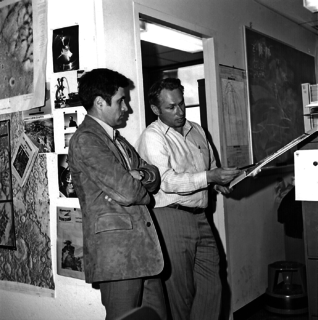| see § List of discovered minor planets |
Timothy Bruce Spahr (born 1970) is an American astronomer and prolific discoverer of minor planets. [2]

An astronomer is a scientist in the field of astronomy who focuses their studies on a specific question or field outside the scope of Earth. They observe astronomical objects such as stars, planets, moons, comets, and galaxies – in either observational or theoretical astronomy. Examples of topics or fields astronomers study include planetary science, solar astronomy, the origin or evolution of stars, or the formation of galaxies. Related but distinct subjects like physical cosmology, which studies the Universe as a whole.

A minor planet is an astronomical object in direct orbit around the Sun that is neither a planet nor exclusively classified as a comet. Before 2006 the International Astronomical Union (IAU) officially used the term minor planet, but during that year's meeting it reclassified minor planets and comets into dwarf planets and small Solar System bodies (SSSBs).
Contents
From 2000–2014 he worked at the Harvard-Smithsonian Center for Astrophysics Minor Planet Center. From September 2006 to December 2014 he was the director of Minor Planet Center. He is a co-discoverer of Callirrhoe, a moon of Jupiter, and of Albiorix, a moon of Saturn. He also discovered two periodic comets: 171P/Spahr and P/1998 U4. He is credited by the Minor Planet Center with the discovery of 58 minor planets. [1]
The Minor Planet Center (MPC) is the official worldwide organization in charge of collecting observational data for minor planets, calculating their orbits and publishing this information via the Minor Planet Circulars. Under the auspices of the International Astronomical Union (IAU), it operates at the Smithsonian Astrophysical Observatory, which is part of the Center for Astrophysics along with the Harvard College Observatory.

Callirrhoe ( kə-LIRR-o-ee; Greek: Καλλιρρόη), also known as Jupiter XVII, is one of Jupiter's outer natural satellites. It is an irregular moon that orbits in a retrograde direction. Callirrhoe was imaged by Spacewatch at Kitt Peak National Observatory from October 6 through November 4, 1999, and originally designated as asteroid (1999 UX18). It was discovered to be in orbit around Jupiter by Tim Spahr on July 18, 2000, and then given the designation S/1999 J 1. It was the 17th confirmed moon of Jupiter.

Albiorix is a prograde irregular satellite of Saturn. It was discovered by Holman and colleagues in 2000, and given the temporary designation S/2000 S 11.
Dr. Spahr is currently the CEO of NEO Sciences LLC, a consulting firm specializing in characterization of Near-Earth Objects (NEOs) including PHAs (Potentially Hazardous Asteroids), Asteroid and Comet science, and planetary defense coordination. Dr. Spahr is the manager of the UN-sanctioned International Asteroid Warning Network (IAWN) and also serves on the advisory council of The Planetary Society where he is the administrator of the Shoemaker NEO Grant program.

A near-Earth object (NEO) is any small Solar System body whose orbit brings it to proximity with Earth. By convention, a Solar System body is a NEO if its closest approach to the Sun (perihelion) is less than 1.3 astronomical units (AU). If a NEO's orbit crosses the Earth's, and the object is larger than 140 meters (460 ft) across, it is considered a potentially hazardous object (PHO). Most known PHOs and NEOs are asteroids, but a small fraction are comets.

A potentially hazardous object (PHO) is a near-Earth object – either an asteroid or a comet – with an orbit that can make close approaches to the Earth and large enough to cause significant regional damage in the event of impact. They are defined as having a minimum orbital intersection distance with Earth of less than 0.05 astronomical units and an absolute magnitude of 22 or brighter. 98% of the known potentially hazardous objects are not an impact threat over the next 100 years.

Asteroids are minor planets, especially of the inner Solar System. Larger asteroids have also been called planetoids. These terms have historically been applied to any astronomical object orbiting the Sun that did not resemble a planet-like disc and was not observed to have characteristics of an active comet such as a tail. As minor planets in the outer Solar System were discovered they were typically found to have volatile-rich surfaces similar to comets. As a result, they were often distinguished from objects found in the main asteroid belt. In this article, the term "asteroid" refers to the minor planets of the inner Solar System including those co-orbital with Jupiter.
The Florian asteroid 2975 Spahr was named after him. [2]
2975 Spahr, provisional designation 1970 AF1, is a bright background asteroid from the Flora region of the inner asteroid belt, approximately 6 kilometers (3.7 miles) in diameter. It was discovered on 8 January 1970, by Russian astronomers Hejno Potter and A. Lokalov at the Cerro El Roble Station near Santiago, Chile. The S- or A-type asteroid has a rotation period of 11.9 hours. It was named for Timothy Spahr, an American astronomer and former director of the Minor Planet Center.





